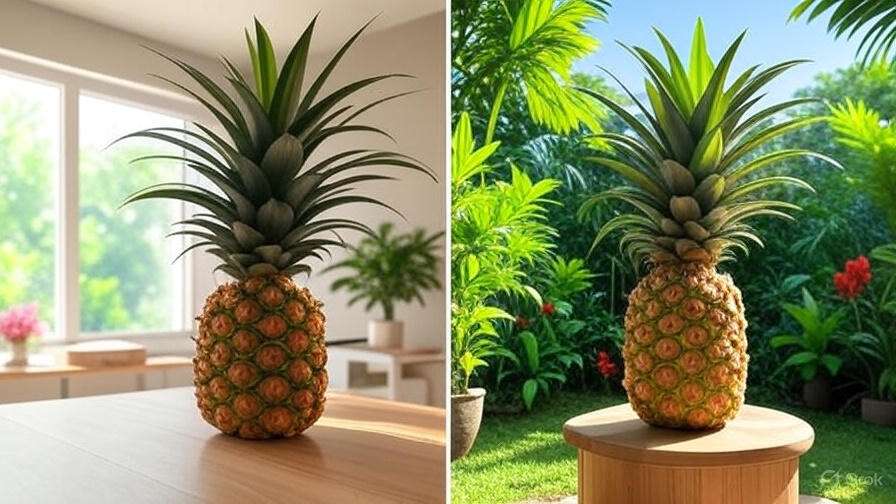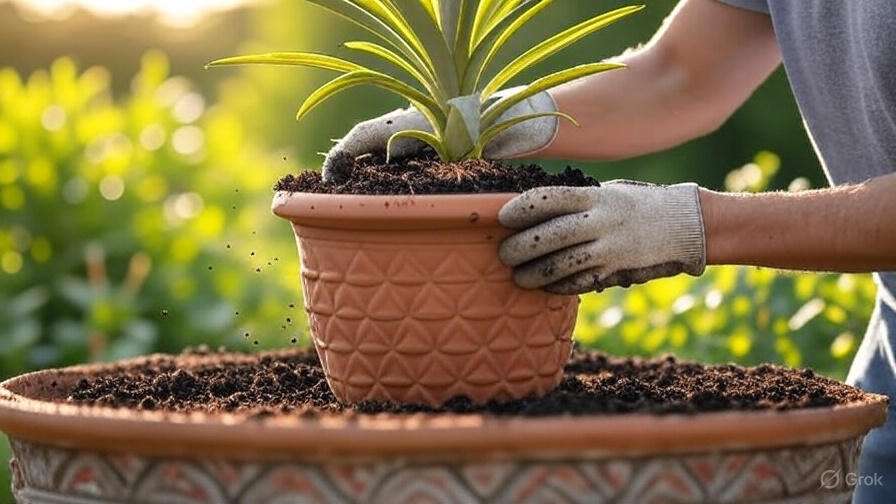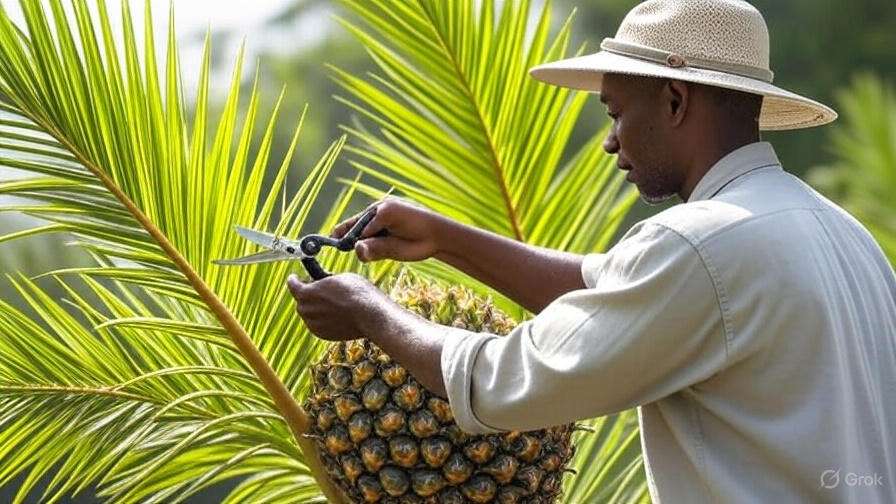
Pineapple Palm Tree: A Complete Guide to Growing, Caring, and Styling Your Tropical Beauty
Imagine bringing a touch of tropical paradise into your home with a stunning pineapple palm tree 
In this comprehensive guide, we’ll walk you through everything you need to know about growing, styling, and maintaining your pineapple palm tree. From choosing the right spot in your home to expert care tips, we’ll ensure you have all the tools to help your pineapple palm thrive with minimal effort. Let’s dive in and turn your space into a tropical oasis!
Table of Contents
ToggleWhat Is a Pineapple Palm Tree? 

The Pineapple Palm Tree (scientific name Nannorrhops ritchiana) is a stunning tropical plant known for its unique appearance and ease of care. This slow-growing palm has a distinctive, pineapple-like crown that gives it its name. It is often chosen for its striking look, which adds a touch of the tropics to both indoor and outdoor spaces.
Key Features:
- Leaf Structure: The Pineapple Palm has long, arching fronds that resemble those of a typical palm, but the plant’s compact, pineapple-like top sets it apart.
- Size: This palm typically grows to about 6-10 feet in height, making it ideal for smaller spaces, but it can also grow larger under optimal conditions.
- Tropical Appeal: Native to regions of South Asia, it thrives in warm climates, adding a tropical flair to gardens, patios, or even inside your home.
The beauty of this plant lies not only in its aesthetic appeal but also in its low-maintenance nature. Whether you’re a seasoned plant lover or a beginner, the Pineapple Palm is an excellent choice to bring the charm of the tropics into your space with minimal effort.

Why Choose a Pineapple Palm Tree?
- Versatile Styling: It can be used as a statement piece in gardens, or even as an indoor decor element for adding lush greenery to any room.
- Low Maintenance: Perfect for busy individuals, this palm requires minimal care and is forgiving of occasional neglect.
In the next sections, we’ll cover everything you need to know about planting, caring for, and styling your Pineapple Palm Tree, so you can enjoy its tropical beauty to the fullest!

How to Choose the Right Pineapple Palm Tree for Your Home 

When selecting a Pineapple Palm Tree for your home, there are a few important factors to consider to ensure that the tree thrives in your space. Follow these simple steps to make the best choice and bring a touch of tropical beauty to your indoor or outdoor environment!
1. Consider the Space Available 
Pineapple Palm Trees can grow quite large, so it’s crucial to assess the space where you plan to place it. These trees can reach up to 10 feet in height, and their fronds can spread wide. Make sure you have enough room for the tree to grow without being cramped. Whether indoors or outdoors, a spacious corner or garden area is ideal.
2. Choose the Right Climate 

While Pineapple Palms are relatively adaptable, they thrive in warm, tropical climates. If you live in a colder region, consider keeping your Pineapple Palm indoors, where it can get plenty of sunlight. If you’re placing it outdoors, ensure your local climate stays above 50°F (10°C) year-round to prevent damage during winter.
3. Lighting Needs 
Pineapple Palm Trees love bright, indirect light. When choosing a spot for your tree, ensure it receives plenty of sunlight but is protected from harsh, direct rays. Indoors, a south or west-facing window works best. Outdoors, place it in a partially shaded spot for optimal growth.
4. Check the Soil Type 
For healthy growth, Pineapple Palms prefer well-draining soil. Ensure the soil in your chosen pot or garden bed drains well to prevent root rot. You can improve drainage by adding sand or perlite to the soil mix.
5. Look for a Healthy Tree 
When purchasing a Pineapple Palm, inspect the tree carefully. Look for lush, green fronds without yellowing or browning tips, which may indicate poor health or improper care. Choose a tree with a strong, sturdy trunk and no visible signs of pests or disease.
6. Size and Growth Rate 
Consider how quickly the tree will grow. If you’re looking for a smaller, more manageable plant, opt for a younger Pineapple Palm. If you want a more mature tree, look for one that’s already a few feet tall. Keep in mind that these trees can take several years to reach their full height.
By following these simple tips, you can choose the perfect Pineapple Palm Tree that will thrive in your home and enhance your space with its tropical charm!

How to Plant and Pot Your Pineapple Palm Tree

Planting and potting your Pineapple Palm Tree (also known as the Pritchardia species) is a simple yet rewarding task that will bring a tropical vibe to any space. Here’s a step-by-step guide to help you get started.
1. Choose the Right Pot 
Start by selecting a pot with good drainage. A pot that’s 2-4 inches larger than the root ball of your Pineapple Palm is ideal. Ensure there are drainage holes at the bottom to avoid waterlogging, which can lead to root rot.
2. Prepare the Soil 
Pineapple Palm Trees thrive in well-draining soil that is slightly acidic. A mix of standard potting soil with added perlite or sand is perfect for this. It will ensure the roots get the aeration they need. You can also add some organic compost to enrich the soil with essential nutrients.
3. Position the Plant 
When placing the tree in the pot, make sure the top of the root ball is level with the top of the pot. Gently spread out the roots if they seem crowded. Ensure that the palm is sitting straight and centered in the pot.
4. Fill and Secure the Roots 
Add soil around the roots, pressing gently as you go. Avoid overpacking the soil, as this can cause the roots to suffocate. Leave about an inch of space from the top of the pot to the soil level. This allows room for watering without overflowing.
5. Water Thoroughly 
After planting, give your Pineapple Palm a good watering to help settle the soil around the roots. Ensure the water drains out of the pot to prevent waterlogging. Keep the soil moist but not soggy for the first few weeks as the tree gets acclimated.
6. Choose the Right Location 
Place your newly potted Pineapple Palm in a spot that receives bright, indirect sunlight. While they enjoy the sun, direct exposure can burn their leaves. If you’re indoors, a spot near a south or west-facing window works best.
7. Potting Maintenance and Care 
Over time, as your Pineapple Palm grows, you may need to repot it into a larger container. Generally, repotting every 2-3 years is enough to give the roots more room to spread and continue thriving.
By following these simple steps, you’ll ensure your Pineapple Palm Tree gets a strong start and continues to flourish in your space!

Essential Care Tips for a Thriving Pineapple Palm Tree 

Pineapple Palm Trees (also known as Pseudophoenix sargentii) are striking tropical beauties that can add a touch of elegance to any garden or indoor space. However, like all plants, they require proper care to thrive. Here are the essential tips to keep your Pineapple Palm Tree healthy, vibrant, and growing strong:
1. Location and Light Requirements 
Pineapple Palm Trees love bright, indirect light. Place your tree near a window with plenty of sunlight but avoid direct, harsh sunlight, as this can scorch its delicate fronds. If you’re growing it indoors, a south-facing window is ideal. Outdoors, choose a partially shaded spot to protect the tree from extreme sun exposure.
2. Watering: Not Too Much, Not Too Little 
The key to keeping your Pineapple Palm happy is the balance of water. Water it thoroughly when the top 1-2 inches of soil feel dry to the touch, but ensure the pot has good drainage to avoid waterlogged roots. Overwatering can lead to root rot, so always let the soil dry slightly between waterings. In winter, reduce watering as the tree’s growth slows.
3. Soil: Well-Draining is a Must 
A Pineapple Palm thrives in well-draining soil. Opt for a potting mix that is slightly acidic and light. A blend of peat, pine bark, and perlite works great, as it allows excess water to escape while keeping the roots healthy. Ensure your pot has drainage holes to prevent standing water.
4. Humidity and Temperature Needs 
This tropical beauty prefers higher humidity and warmer temperatures. Aim for temperatures between 65-85°F (18-29°C). If you’re growing it indoors in a dry environment, consider using a humidity tray or a humidifier to keep the air moist. In winter, avoid placing the tree near heat vents or cold drafts.
5. Fertilizing for Growth and Vibrancy 
During the growing season (spring and summer), feed your Pineapple Palm every 4-6 weeks with a balanced liquid fertilizer. This will support healthy growth and enhance the tree’s vibrant foliage. Reduce fertilizing in the fall and winter months when the plant is not actively growing.
6. Pruning and Cleaning 
Regularly remove dead or yellowing fronds to maintain the tree’s clean and attractive appearance. Be gentle while trimming to avoid damaging the healthy parts of the plant. Dust the fronds occasionally with a damp cloth to keep them shiny and free from debris.
7. Repotting When Necessary 
Pineapple Palms don’t mind being slightly root-bound, but if your tree starts to outgrow its pot, it’s time to repot. Choose a pot that is just one size larger than the current one and ensure it has good drainage. Repot during the spring or early summer when the plant is actively growing.
8. Pest Control: Stay Vigilant 
While Pineapple Palms are generally pest-resistant, they can still fall prey to mealybugs, scale insects, and spider mites. Inspect the plant regularly for any signs of pests, such as sticky residue or discolored fronds. If you spot pests, treat the affected area with insecticidal soap or wipe the fronds with a damp cloth.
By following these simple care tips, your Pineapple Palm Tree will flourish, bringing a piece of the tropics right to your home!

Pruning and Maintenance: Keeping Your Pineapple Palm Tree Healthy 
Caring for your Pineapple Palm Tree doesn’t end with planting—it’s essential to prune and maintain it regularly to ensure it stays healthy and vibrant. Pruning is an easy and effective way to encourage growth, remove dead or damaged fronds, and maintain the plant’s shape.
Why Pruning is Important 
Pruning helps your Pineapple Palm tree:
- Promote Healthy Growth: Removing old or damaged leaves makes way for new growth, allowing your palm to thrive.
- Prevent Disease: Dead or decaying fronds can attract pests or diseases, so it’s best to remove them promptly.
- Maintain Aesthetic Appeal: A well-pruned tree looks more structured and attractive in your home or garden.
When to Prune 
Prune your Pineapple Palm during the growing season—typically in spring or early summer. This ensures the plant is actively growing and can recover quickly from pruning.
How to Prune Your Pineapple Palm 
- Start with Dead or Damaged Leaves: Use sharp, clean pruning shears to remove any yellow, brown, or damaged fronds. Cut as close to the base as possible without damaging the main trunk.
- Trim Old Growth: If any older fronds are crowding newer growth or blocking light, trim them back to allow better airflow and light penetration.
- Cut Back Flowering Stems: If your palm has flowered and the blooms have faded, trim the spent flower stalks. This will redirect the plant’s energy to healthy new growth.
- Avoid Over-Pruning: Don’t cut too many leaves at once, as the plant may become stressed. Focus on removing only the leaves that are necessary for overall health.
Maintenance Tips for Healthy Growth 
- Watering: Pineapple Palms prefer to stay slightly moist but not soggy. Ensure the soil is well-draining to prevent root rot.
- Fertilize Lightly: Feed your plant with a balanced liquid fertilizer every few months during the growing season to encourage healthy foliage.
- Check for Pests: Regularly inspect the fronds for signs of pests, like scale or mealybugs. If you spot any, treat them with insecticidal soap or wipe them off with a damp cloth.
- Repot When Necessary: If your palm outgrows its pot, consider repotting it into a larger container to give the roots room to spread.
By following these pruning and maintenance steps, your Pineapple Palm Tree will continue to grow healthy and strong, adding a beautiful tropical touch to your space!

Styling and Decorating with Pineapple Palm Trees 

Pineapple palm trees are not only a stunning addition to your garden but also a fantastic way to bring the tropical vibes indoors. Their unique, spiky foliage and vibrant colors can transform any space into a paradise. Whether you’re styling your living room, balcony, or garden, here are some practical tips for decorating with these beautiful trees.
1. Indoor Styling with Pineapple Palm Trees 
If you’re bringing your pineapple palm indoors, consider placing it near a bright window where it can get plenty of sunlight. These plants thrive in well-lit spaces, so a spot near your living room or a sunroom is ideal. Try putting it in a stylish planter to match your room’s décor. A neutral-toned pot with a glossy finish works well for modern interiors, while a rustic, terracotta pot complements more natural settings.
2. Creating a Tropical Corner 
Set up a tropical corner by grouping the pineapple palm with other lush indoor plants like monstera or snake plants. This creates a vibrant, green oasis right in your home! For added flair, layer different heights and textures—mixing the smoothness of the palm with the bold leaves of other plants can create a visually interesting arrangement.
3. Balcony or Patio Styling 
Pineapple palms are perfect for enhancing outdoor spaces like balconies, patios, or garden areas. Place them in a large decorative planter for a striking focal point. For a tropical escape, pair your pineapple palm with outdoor furniture in neutral colors, such as beige or soft grays, and add cozy cushions to complete the look. You could even add string lights around the tree for a magical, evening ambiance.
4. Tropical Accents in Your Home 
For a more subtle tropical touch, use the pineapple palm as a statement piece in the entryway or alongside a staircase. A single tree in a stylish planter can add instant personality to these often-overlooked areas. To make it pop, consider pairing the palm with other tropical-themed accessories, like bright throw pillows, tropical art prints, or woven baskets.
5. Mixing with Other Plants for a Stunning Display 
While the pineapple palm tree is eye-catching on its own, mixing it with other plants can create a beautiful garden-like vibe indoors or outdoors. Pair it with flowering plants like hibiscus or bougainvillea for a burst of color, or keep it simple with low-maintenanceplants like succulents and aloe vera.
6. Caring for Your Pineapple Palm in Style 

Don’t forget that styling your palm tree is also about ensuring it thrives. Pineapple palms need regular watering, but be sure the soil drains well to avoid waterlogging. Regular pruning will help maintain a clean, structured look, while occasional fertilizing will encourage healthy growth.
By following these styling tips, you can easily elevate any space with the charm and elegance of pineapple palm trees, creating a tropical atmosphere wherever you are.

Conclusion
Pineapple palm trees are a stunning and low-maintenance addition to any space, bringing a touch of tropical beauty that can transform both indoor and outdoor environments. With the right care—whether it’s selecting the right pot, providing the ideal lighting, or maintaining proper watering and humidity levels—you’ll enjoy a thriving, vibrant plant that adds both style and natural elegance to your home or garden.

Now that you have all the tips and insights for growing, caring for, and styling your pineapple palm tree, it’s time to get started! Bring the tropics into your space and watch your pineapple palm tree flourish. Happy planting, and enjoy the beauty this tropical beauty brings into your life!
Frequently Asked Questions(FAQ)
How much sunlight does a pineapple palm tree need?
A pineapple palm tree thrives in bright, indirect sunlight. Direct sunlight can scorch its leaves, so it’s best to place it near a window where it receives plenty of light but without the harsh rays. If growing indoors, make sure it’s not too far from natural light sources.
Can I grow a pineapple palm tree indoors?
Yes, pineapple palm trees can thrive indoors as long as they get enough light, warmth, and humidity. Choose a spot with indirect sunlight, and make sure the temperature stays between 65-75°F (18-24°C). Regularly check the humidity and consider using a humidifier if the air is too dry.
How often should I water my pineapple palm tree?
Water your pineapple palm tree when the top inch of the soil feels dry. It’s important to avoid overwatering, as this can lead to root rot. Always ensure the pot has good drainage to prevent water from sitting at the bottom.
Why are the leaves of my pineapple palm tree turning yellow?
Yellowing leaves can be caused by several factors, including overwatering, nutrient deficiencies, or insufficient light. Check the soil moisture to avoid overwatering and ensure the palm is getting enough indirect sunlight. Fertilizing with a palm-specific fertilizer may also help address nutrient gaps.
How can I keep my pineapple palm tree healthy during the winter?
During the winter, reduce watering as the plant enters a dormant phase. Keep it in a warm spot with indirect light, and consider using a humidifier or misting the leaves to maintain humidity. Avoid placing it near drafty windows or heaters, as temperature fluctuations can stress the plant.
How do I style my pineapple palm tree in my home?
Pineapple palm trees make a bold statement as a centerpiece or accent in your living room, office, or entryway. For best results, place it in a decorative pot that complements your décor. Grouping it with other tropical plants can create a beautiful, lush indoor garden.
Can I grow a pineapple palm tree outdoors?
Yes, if you live in a warm climate, you can grow a pineapple palm tree outdoors in a sunny spot with well-draining soil. Make sure to protect the tree from frost, as it’s not cold-hardy. If you live in a region with colder winters, consider growing it in a container so you can bring it indoors during the winter months.
What kind of fertilizer should I use for my pineapple palm tree?
Use a slow-release, balanced fertilizer designed for palms. Apply the fertilizer during the growing season (spring and summer) every 4-6 weeks. Avoid fertilizing during the winter when the plant is not actively growing to prevent overfeeding and possible damage.


